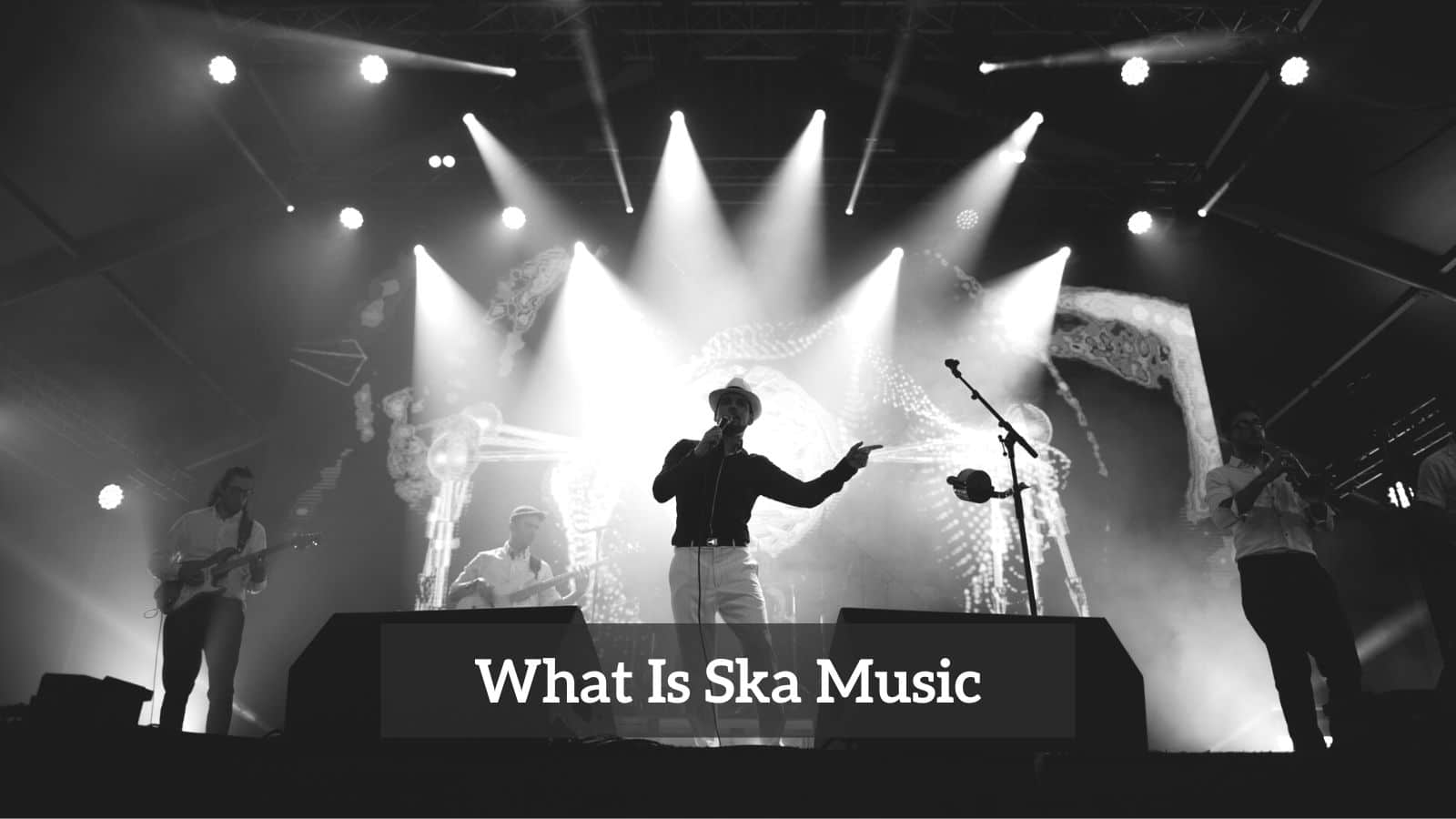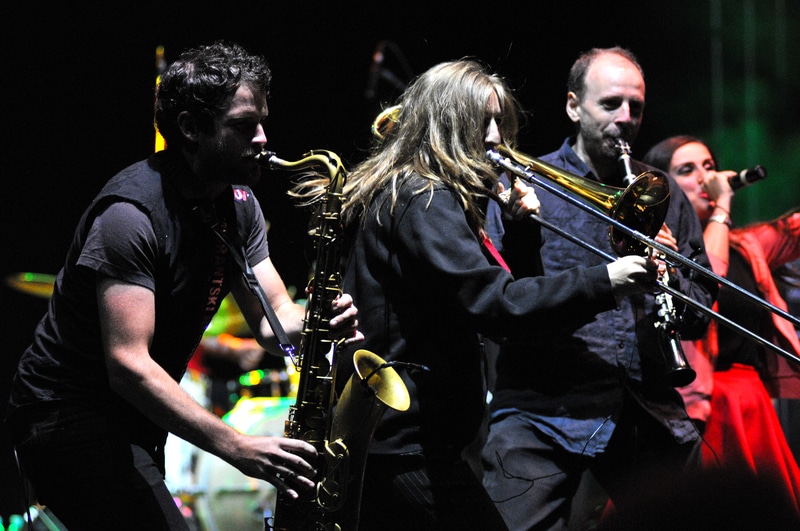
After WWII, there was an influx of radios to Jamaica. For the first time, people were exposed to the sounds of American Jazz and RnB apart from the calypso and mento music they grew up with.
Artists began experimenting with cover versions of the music they heard but put their own spin on the music they heard.
What Is Ska Music
Traits of Ska Music
Ska was first and foremost a dance genre, and the music is almost exclusively composed in a 4/4-time signature. However, the emphasis or accents fell on the drums and bass guitar’s second and third beats (the backbeat).
Guitarists often present percussive sounds that sound onomatopoeically like a ‘ska’ or ‘skank’ or ‘skunk’ sound in the second, third, and fourth beats.
Typically, you’d find rock instruments such as the guitar, bass guitar, and drum alongside saxophone, trumpet, and trombone, which are associated with jazz.
A lead vocalist will perform the lyrics. Some bands also include keyboards. During the lead singer’s vocals, the horns are sometimes silent. They are primarily used to play riffs between the vocalist’s lyrics.
A Story Told in Three Waves
Music historians divide ska music into three periods or waves: the first wave originated in Jamaica around the 1960s, the second wave was known as the English 2 Tone Ska revival of the late 1970s, and the third wave rose to popularity in the 1980s, and picked up momentum in the US during the 1990s.
Let’s unpack these below with information and links to representative videos and artists.
First Wave Ska
When Jamaica gained independence from the UK in the 1960s, ska also experienced its first wave of popularity. Unfortunately, we cannot pinpoint a single person or group as the creator(s) of ska music because Jamaican tradition is typically oral.
In 1964 the first ska hit to make international headlines and reach a wider audience was recorded by Millie Small. Small’s song My Boy Lollipop came second on the UK and US charts and sold over 6 million copies.
Other notable ska bands and artists include:
- Toots & The Maytals – Never Grow Old.
- The Skatalites – Guns of Navarone. While the vocals are sparse, it is easy to hear the development of the ska sound—prominent brass and an organ keyboard are used to carry the melodic lines.
- Duke Reid – Twilight Zone.
Second Wave Ska—UK
While the Jamaican scene started to fade towards the end of the 1960s due to reggae and rocksteady becoming more popular in Jamaica, ska enjoyed a surge in popularity in the UK.
The English record label 2 Tone led the scene. Lyrics focussed on pushing back against Margaret Thatcher’s Conservative-led government, addressing and fighting against racism, and promoting racial integration.
Influential bands include:
- The Specials – Too Much Too Young deals with the frustrations of an almost-relationship with a married woman, but both parties walk away for the sake of the woman’s marriage and child.
- The English Beat – Mirror in the Bathroom is a song about self-reflection while looking into a proverbial mirror.
- Madness – Our House deals with the struggles of the middle class in England, making ends meet, keeping up appearances, and adults being forced to move in back with their parents.
Second Wave Ska—USA
The USA came to the ska scene relatively late, emulated the Jamaican style of music, and incorporated the social justice messages from Jamaican influence.
The lines start to get blurry between ska and other types of music, such as punk rock, but the ska influence is still strong during the second wave.
Significant groups include:
- The Toasters – Don’t Let the Bastards Grind Your Down talks about earning minimum wage and managers expecting too much from their employees while employees try their best to cope with work stress and stay true to their core. The Toasters also laid the groundwork for the ska scene in New York.
- The Uptones – No More. As a part of the Northern California ska scene, they borrowed from the British wave while preserving elements of Jamaican ska. Instead of deriving fame from record sales, they drew notoriety from their live shows.
- The Aquabots – Super Rad. The Aquabots was formed in 1994 and is regarded as a predecessor to the third wave of ska. They refer to themselves as the “world’s greatest superhero rock band” by dressing up in superhero costumes during their live shows and music videos. Super Rad has gained an enormous following of dedicated fans on the internet.
Third Wave Ska
The third wave was primarily seen in the USA during the 1990s, where the first and second-wave elements became mixed with pop punk music. The music took on a grungier sound thanks to the influence of punk, became more dance-oriented, and was heavily melodic and energetic.
Groups started using distorted guitars and scaled back the horn section leading to hybrid versions like ska-core and ska-punk. Due to nu-metal and alternative rock becoming the main genres, ska was slowly fading into the background.
Notable third wave groups include:
- Reel Big Fish – Sell Out. The band formed in 1990 in Orange County and became a fixture in the third wave. The band began as a high school cover band and has been a firm fixture in the underground ska world since releasing their debut album, Everything Sucks, in 1992.
- No Doubt – Don’t Speak. Technically, No Doubt isn’t a pure ska band; however, they embrace an eclectic mix of genres, and their off-beat rhythms and basslines directly borrow from ska. They perform in a fusion of punk, new wave, and alternative rock, and the band pushed ska into the mainstream with their unique approach. Their album Tragic Kingdom can be regarded as a contribution to ska’s third wave.
- Streetlight Manifesto can be described as post-third wave or fourth wave ska. Their music acknowledges European music influences from the 1950s and 1960s. Tomas Kalnoky was a famous musician during the third wave of the 1990s.
Conclusion
Although ska music seems to drift in and out of the mainstream, we cannot underestimate its influence.
The energetic tempos and sometimes cheeky other times profound culture draw listeners from all demographics worldwide—from carefree and sometimes silly lyrics to politically loaded lyrics.
Ska is an example of how people can express their feelings through the power of music. For a deeper understanding of ska, follow this link.

